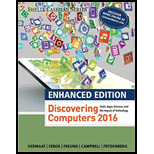
Explanation of Solution
Use of verification system by a company:
Companies use the verification system in the following manner. They are mentioned below:
Fingerprint reader:
Fingerprint reader is also referred to as fingerprint scanner that scans or captures the fingerprint bends and indentations.
- Some companies use the fingerprint reader to provide the security to doors, systems, and software.
- Some fingerprint software are installed into a system, mobile phone, and so on to lock and unlock the system.
Face recognition system:
Face recognition system helps to capture the images of face.
- It compares with computer image. If the faces match, then the person or user is a legitimate person. Otherwise, the person or user is an unauthorized person.
- Some mobile devices use this type of verification to unlock the mobile.
- Some companies use this recognition system to provide the security to access the room.
Hand geometry system:
The hand geometry system helps to capture the hand shape and size.
- It compares the captured image of hand with computer images.
- If it matches, then the user is a legitimate person. Otherwise, the person or user is an unauthorized person.
- It can be used in colleges, hospitals, daycare centers, and so on.
- This type of recognition is used for huge companies to track the timing and attendance of the employees.
Voice verification system:
Voice verification system helps to compare the legitimate voice with a stored pattern of voice in the computer...
Biometric devices:
Biometric device is a device that helps to authenticate the identity of a person by translating the fingerprint into a digital code.
- The code that is given by a person for identification is compared with a digital code that is present in a computer, and it helps to check the behavioral and physical features of the devices.
- If a code matches with a computer code, then access to a computer is given to an individual.
- When it does not match, access to computer is not given to that individual.
Trending nowThis is a popular solution!

Chapter 5 Solutions
Enhanced Discovering Computers 2017 (Shelly Cashman Series) (MindTap Course List)
- Data communıcatıon digital data is transmitted via analog ASK and PSK are used together to increase the number of bits transmitted a)For m=8,suggest a solution and define signal elements , and then draw signals for the following sent data data = 0 1 0 1 1 0 0 0 1 0 1 1arrow_forwardDatacommunicationData = 1 1 0 0 1 0 0 1 0 1 1 1 1 0 0a) how many bıts can be detected and corrected by this coding why prove?b)what wıll be the decision of the reciever if it recieve the following codewords why?arrow_forwardpattern recognitionPCA algor'thmarrow_forward
- Consider the following program: LOAD AC, IMMEDIATE(30) ADD AC, REGISTER(R1) STORE AC, MEMORY(20) Given that the value of R1 is 50, determine the value stored at memory address 20 after the program is executed. Provide an explanation to support your answer.arrow_forwardPattern RecognitonDecision Tree please write the steps not only last answerarrow_forwardPattern RecognitionPCA algorithmplease write the steps not only last answerarrow_forward
- Please original work Final Project: Part I Background Information: E-TechMart, established in 2005, has grown to become a leading global electronics retailer, renowned for its extensive range of electronic devices and accessories. With a robust online platform and numerous brick-and-mortar stores spread across various regions, E-TechMart serves millions of customers worldwide. The company's product offerings include the latest smartphones, laptops, tablets, smart home devices, and a variety of electronic accessories, catering to both individual consumers and businesses. E-TechMart has always prioritized customer satisfaction and aims to provide an exceptional shopping experience. This commitment is evident in their comprehensive customer service, competitive pricing, and a well-organized loyalty program that rewards repeat customers. Despite these strengths, E-TechMart faces increasing competition from other major players in the electronics retail market. To maintain its competitive…arrow_forwardCan you show me how to redesign the GameStop website using HTML and CSS using Sublime Text?arrow_forwardManhattan distancearrow_forward
- Aiwhat cost from Oradea to Goal which Eforie us A* Algorithm G(n)+H(n) last what ıs the costarrow_forwardWhat is the SELECT statement? give one reference with your answer What is a URL and what is it used for? give one reference with your answer What is e-mail, and what are its advantages? Give one reference with your answerarrow_forwardWhat is the difference between the World Wide Web (WWW) and the Internet? Give two references from a journal along with your answer.arrow_forward
 Enhanced Discovering Computers 2017 (Shelly Cashm...Computer ScienceISBN:9781305657458Author:Misty E. Vermaat, Susan L. Sebok, Steven M. Freund, Mark Frydenberg, Jennifer T. CampbellPublisher:Cengage Learning
Enhanced Discovering Computers 2017 (Shelly Cashm...Computer ScienceISBN:9781305657458Author:Misty E. Vermaat, Susan L. Sebok, Steven M. Freund, Mark Frydenberg, Jennifer T. CampbellPublisher:Cengage Learning
